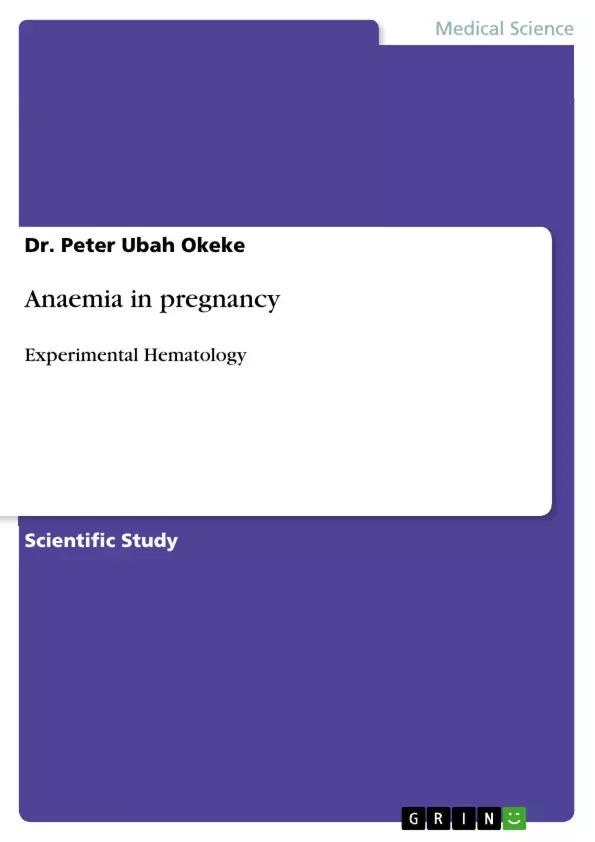A total of 160 blood samples were collected into EDTA tubes between 1- January to 31-march 2011, at the Antenatal Clinic of Hospital of Porto Novo during the first visit of the pregnant women to the reproductive section and Using Sysmex KX-21-N by Sysmex corporation, Japan. The haematological parameters of Haemoglobin (Hb), Haematocrit (HCT), Mean Cell Volume (MCV) and Red Cell Distribution Width in coefficient variation (RDW-CV) were determined in all the samples; the trimester stages of each pregnancy were noted. Out of the 160 pregnant women blood samples analyzed, 62(38.8%) were anaemic, and the majority 71% were mildly anaemic cases, whereas 29% were moderately anaemic and no severe anaemic cases were recorded. Iron deficiency anaemia was 8.1% whereas 91.9% showed mixed anaemia indicating Normocytic- Normochromic. Anaemia was higher (53.2%) in pregnant women in the second trimester. CONCLUSION: The administration of iron with folic acid (folicferro), vitaminB12 and food aid program should be re-inforced for all pregnant women.
Inhaltsverzeichnis (Table of Contents)
- Abstract
- Introduction
- Materials and Methods
- Results
- Discussion
- Conclusion
- Reference
- Appendices
- Prophylaxis
- Iron Rich Foods
- Oral Iron Therapy
- Iron Salt Selection
- Timing of Oral Iron Intake in Relation to Food
- Parenteral Iron
- TDI Reaction
- Calculating TDI
- Contraindication of Parenteral Iron Therapy
- Severe Anaemia in Late Pregnancy (After 32 weeks)
Zielsetzung und Themenschwerpunkte (Objectives and Key Themes)
This research focuses on the prevalence, types, and causes of anaemia in pregnant mothers in the Porto Novo Province of Cape Verde. The study aims to inform healthcare providers about the prevalence of anaemia in this region and emphasize the importance of early detection and prompt management. The main themes explored in the text include: * Prevalence of anaemia in pregnant women * Types of anaemia in pregnant women * Causes of anaemia in pregnant women * Public health implications of anaemia in pregnancy * Importance of early detection and management of anaemiaZusammenfassung der Kapitel (Chapter Summaries)
Abstract
This chapter presents a summary of the research findings, highlighting the prevalence of anaemia among pregnant women in the Porto Novo Province. The study found that 38.8% of pregnant women were anaemic, with the majority exhibiting mild anaemia. Iron deficiency anaemia accounted for a smaller percentage, while mixed anaemia was more prevalent.Introduction
This chapter provides a comprehensive overview of anaemia as a global health concern, particularly affecting pregnant women and young children. It discusses the classification of anaemia based on haemoglobin levels and haematocrit percentage, as well as the different etiological classifications, with nutritional deficiencies being the most common cause. The chapter further emphasizes the impact of anaemia on individuals, particularly pregnant women, and highlights the increased demand for nutrients like iron and folic acid during pregnancy.Materials and Methods
This chapter details the methodology employed in the study. Blood samples were collected from pregnant women during their first antenatal visit at the Hospital of Porto Novo. Haematological parameters, including haemoglobin, haematocrit, mean cell volume, and red cell distribution width, were measured using a Sysmex KX-21-N analyser.Results
This chapter presents the results of the study, revealing that a significant proportion of pregnant women in the Porto Novo Province were anaemic. The study also identified the prevalence of different types of anaemia and highlighted the higher incidence of anaemia in the second trimester.Schlüsselwörter (Keywords)
The core keywords and concepts of this study include anaemia, pregnancy, prevalence, public health, Porto Novo, Cape Verde, iron deficiency, mixed anaemia, and antenatal care. This study underscores the significance of understanding the prevalence and characteristics of anaemia in pregnancy, particularly in developing countries, for implementing effective public health interventions and improving maternal and fetal outcomes.- Quote paper
- Dr. Peter Ubah Okeke (Author), 2012, Anaemia in pregnancy, Munich, GRIN Verlag, https://www.hausarbeiten.de/document/202272


